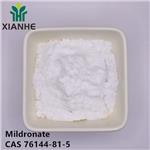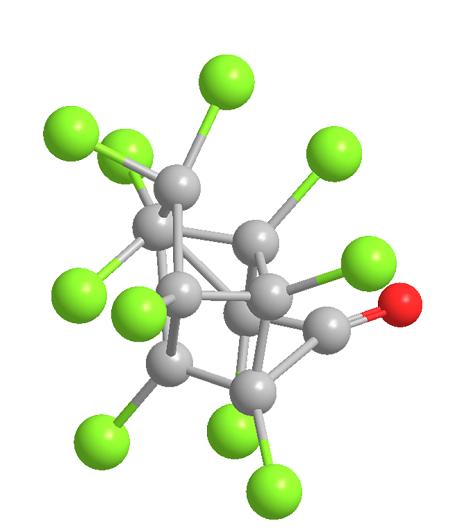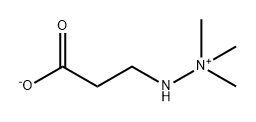Mildronate: An Antiischemic Drug for Neurological Indications
Jan 6,2022
General description
Lixisenatide (Adlyxin, Sanofi-Aventis) is the newest FDA-approved GLP-1RA and Midrohydrazine (also known as THP, MET-88 and mildronate) is a new type of heart protective drug. It was developed by the latovia Institute of organic synthesis and first sold in the former Soviet Union by grindeks company in 1989. It is a structural analog of carnitine, with a chemical name of 3 - (2,2,2-trimethylhydrazine) propionate dihydrate. Later, it was registered and listed in more than 20 countries such as Russia, Turkey, India and Romania. Water soluble, easily soluble in water; Slightly soluble in ether; Almost insoluble in acetone, white or almost white crystalline powder.
Application and Pharmacology
Meldonium is an ammonium betaine that is beta-alaninate in which one of the amino hydrogens is replaced by a trimethylamino group. A clinically used cardioprotective drug that is used for treatment of heart failure, myocardial infarction, arrhythmia, atherosclerosis and diabetes. It has a role as a cardioprotective agent, a neuroprotective agent and an EC (gamma-butyrobetaine dioxygenase) inhibitor.[1]
Mildronate (3-(2,2,2-trimethylhydrazinium)propionate; MET-88; meldonium, quaterine) is an antiischemic drug developed at the Latvian Institute of Organic Synthesis. Mildronate was designed to inhibit carnitine biosynthesis in order to prevent accumulation of cytotoxic intermediate products of fatty acidâ-oxidation in ischemic tissues and to block this highly oxygen-consuming process. Mildronate is efficient in the treatment of heart is chemia and its consequences. Extensive evaluation of pharmacological activities of mildronate revealed its beneficial effect on cerebral circulation disorders and central nervous system (CNS) functions. The drug is used in neurological clinics for the treatment of brain circulation disorders. It appears to improve patients’ mood; they become more active, their motor dysfunction decreases, and asthenia, dizziness and nausea become less pronounced. Since the brain does not utilize fatty acids as fuel other mechanisms of action of mildronate in CNS should be considered. Several reports indicate the possible existence of an alternative, non-carnitine dependent mechanism of action of mildronate. Our recent findings suggest that CNS effects of mildronate could be mediated by stimulation of the nitric oxide production in the vascular endothelium by modification of the ã butyrobetaine and its esters pools. It is hypothesized that mildronate may increase the formation of the ã-butyrobetaine esters. The latter are potent cholinomimetics and may activate eNOS via acetylcholine receptors or specificã-butyrobetaine ester receptors. This article summarizes known pharmacological effects of mildronate, its pharmacokinetics, toxicology, as well as the proposed mechanisms of action.[2](Fig.1)
Figure1. Carnitine biosynthesis with the site of the inhibitory action of mildronate
Toxicity and adverse effect
Long-term meldonium treatment lowers L-carnitine contents and induces adaptive effects by causing changes in energy metabolism pathways and in the concentrations of the cardiometabolic risk markers acylcarnitines and TMAO, which are beneficial in the treatment of heart diseases and diabetes. L-carnitine homeostasis is a valuable target for the regulation of energy metabolism pathways and for the treatment of metabolic diseases. [2,3]
History
During the Soviet war in Afghanistan, because the Soviet army was often located at high altitude, soldiers would generally suffer from discomfort such as lack of oxygen and blood supply after they marched 20 kilometers with full armed forces. To this end, the Soviet Army asked soldiers with severe altitude reaction to take medrohydrazine for 4 to 6 weeks to promote blood flow and improve human oxygen uptake and endurance. Because of this, midrohydrazine was identified as a banned stimulant in the West. In fact, it is not new to let soldiers "take drugs" to maintain the combat effectiveness of the troops in wartime. According to the German newspaper Le Monde, during World War II, Nazi Germany gave the German army a large number of drugs called "stu card" (stu card was the main dive bomber of the German army at that time) and "armored chocolate" (the main component is methamphetamine, that is, the synthetic effective substance called methamphetamine today), which were used to alleviate fatigue, headache, seasickness and mountain reactions.
Reference
1.Sjakste N., Gutcaits A. & Kalvinsh I., "Mildronate: an antiischemic drug for neurological indications," CNS Drug Rev, Vol.11, No.2(2005), pp.151-168.
2.Schobersberger W., Dünnwald T. & Gmeiner G. et al., "Story behind meldonium–from pharmacology to performance enhancement: a narrative review," British Journal of Sports Medicine, Vol.51, No.1(2016), pp.22-25.
3., "Pharmacological effects of meldonium biochemical,".
- Related articles
- Related Qustion
- Mildronate: Overview and Pharmacological Activity Dec 16, 2024
Meldonium is classified as a partial inhibitor of fatty acid oxidation; it binds to and competitively inhibits gamma-butyrobetaine hydroxylase.
- Mildronate: mechanism of action, clinical applications and side effect Oct 18, 2023
Mildronate treats cardiovascular disorders through carnitine regulation and glucose oxidation, but requires careful monitoring for potential side effects.
Chlordecone, commonly known as kepone, is a tan to white crystalline odorless solid that was used primarily as insecticide. Specific application included control of the rust mites in nonfruit- bearing citrus trees, control of wireworms in t....
Jan 5,2022Analytical ChemistryCitric Acid Monohydrate is a tricarboxylic acid found in citrus fruits. Citric acid is used as an excipient in pharmaceutical preparations due to its antioxidant properties.....
Jan 6,2022Organic Synthesis IntermediateMildronate
76144-81-5You may like
- Mildronate
-

- $0.00 / 1kg
- 2025-12-15
- CAS:76144-81-5
- Min. Order: 1kg
- Purity: 0.99
- Supply Ability: 1000kg
- Mildronate
-

- $0.00 / 1Kg/Bag
- 2025-12-15
- CAS:76144-81-5
- Min. Order: 1KG
- Purity: 99%min, injection
- Supply Ability: 100kg
- Meldonium;Mildronate
-

- $30.00/ g
- 2025-12-15
- CAS:76144-81-5
- Min. Order: 100g
- Purity: 99%
- Supply Ability: 1000kg






